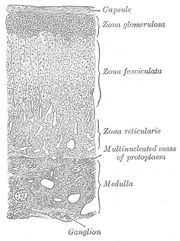No edit summary |
|||
| Line 29: | Line 29: | ||
==References== |
==References== |
||
| + | <references/> |
||
| − | *Carmichael, S.W. and Winkler,H. (1985). The adrenal chromaffin cell, Scientific American 253:40-49, [August] |
+ | *Carmichael, S.W. and Winkler,H. (1985). The adrenal chromaffin cell, Scientific American 253:40-49, [August] |
==External links== |
==External links== |
||
Revision as of 07:53, 23 August 2012
Assessment |
Biopsychology |
Comparative |
Cognitive |
Developmental |
Language |
Individual differences |
Personality |
Philosophy |
Social |
Methods |
Statistics |
Clinical |
Educational |
Industrial |
Professional items |
World psychology |
Biological: Behavioural genetics · Evolutionary psychology · Neuroanatomy · Neurochemistry · Neuroendocrinology · Neuroscience · Psychoneuroimmunology · Physiological Psychology · Psychopharmacology (Index, Outline)



Adrenal gland. (Medulla labeled at bottom right.)
Chromaffin cells are neuroendocrine cells found in the medulla of the adrenal gland (suprarenal gland, located above the kidneys) and in other ganglia of the sympathetic nervous system. They are modified post-synaptic sympathetic neurons that receive sympathetic input. Instead of releasing neurotransmitter (catecholamines - ~20% Norepinephrine (Noradrenaline) and ~80% Epinephrine (Adrenaline)) to an adjacent organ or tissue for a specific effect, neurotransmitter is released into systemic circulation for systemic effects on multiple organs. Hence they are called neuroendocrine cells.
In the fifth week of (human) fetal development, neuroblast cells migrate from the neural crest to form the sympathetic chain and preaortic ganglia. The cells migrate a second time to the adrenal medulla. Chromaffin cells also settle near the sympathetic ganglia, vagus nerve, paraganglia, and carotid arteries. In lower concentrations, extra-adrenal chromaffin cells also reside in the bladder wall, prostate, and behind the liver.
Etymology
The word 'Chromaffin' comes from a portmanteau of chromium and affinity. Histiologically, chromaffin cells pick up a chromatin stain and thus they were given the name.
Function

Chromaffin cells of the adrenal medulla are innervated by the splanchnic nerve and secrete adrenaline (epinephrine), noradrenaline (norepinephrine), and enkephalin and enkephalin-containing peptides into the blood stream. The secreted adrenaline and noradrenaline play an important role in the fight-or-flight response. The enkephalins and enkephalin-containing peptides are related to, but distinct from endogenous peptides named endorphins (which are secreted from the pituitary); all of these peptides bind to opioid receptors and produce analgesic (and other) responses. The hormones are secreted from granules; this is where the enzyme dopamine β-hydroxylase catalyzes the conversion of dopamine to noradrenaline. Distinct N and E cell forms exist (also Na and A cells in British nomenclature - noradrenaline and adrenaline); the former produce norepinephrine, the latter arise out of N cells through interaction with glucocorticoids, and convert norepinephrine into epinephrine.[1]
Nomenclature
These cells are so-named because they can be visualized by staining with chromium salts. Chromaffin salts oxidize and polymerize catecholamines to form a brown color, most strongly in the cells secreting noradrenaline.
(The enterochromaffin cells cells are named because of their histological similarity to chromaffin cells, but their function is quite different.)
=Techniques for studying chromaffin cells
Chromaffin cells can be studied in culture and are easily obtained from the adrenal glands of cattle by perfusion with a solution of collagenase.
Video
Mouse Adrenal Chromaffin Cell Isolation
References
- ↑ (2006) Wheater's Functional Histology, 5th, Edinburgh: Churchill Livingstone.
- Carmichael, S.W. and Winkler,H. (1985). The adrenal chromaffin cell, Scientific American 253:40-49, [August]
External links
- Histology at Boston University 14507loa - "Endocrine System: adrenal gland, reticularis and medulla"
- Secretion Control in Adrenal Chromaffin Cells
- UC-San Diego Chromaffin Cell and Hypertension Research
- A Primer on Chromaffin Cells
- Rat Chromaffin cells primary cultures: Standardization and quality assessment for single-cell assays (a protocol)
| This page uses Creative Commons Licensed content from Wikipedia (view authors). |